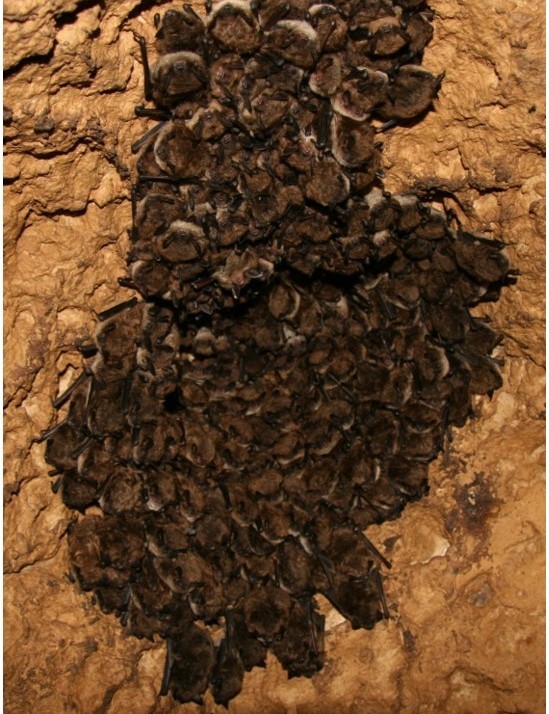
Large bat group in roost photo provided by Dr. Craig Willis
Bats provide crucial ecosystem services:
• Bats play an essential role in pest control, pollinating plants and dispersing seeds. Recent studies estimate that bats eat enough pests to save more than $1 billion per year in crop damage and pesticide costs in the United States corn industry alone.
• While many bats eat insects, others feed on nectar and provide critical pollination for a variety of plants like peaches, cloves, bananas and agaves. In fact, bats are the sole pollinator for the agave plant, a key ingredient in tequila, and are the primary pollinator of the iconic saguaro cactus, a keystone species in the Sonoran Desert.
• A third bat food source is fruit, leading to yet another important role in the ecosystem - seed dispersal. Fruit-eating bats can account for as much as 95% of the seed dispersal responsible for early growth in recently cleared rainforests.
Bats are in real trouble in North America:
• One third of all North American mammal species are bats. More than half of the bat species are at risk from threats including climate change, wind energy production, disease, and habitat loss.
• Bats are affected by White Nose Syndrome (WNS), a disease caused by a fungal pathogen. The disease increases arousal frequency in hibernating bats, with bats warming up in winter three times more than normal, costing them crucial energy they need to survive. WNS also causes skin lesions on the bats’ wings. Bats lose water and salts through these lesions resulting in severe hypothermic dehydration.
• Wildfire smoke is a threat to bats as females will not leave their roost to feed on smokey nights, so their pups don’t get the nourishment they need and die.
• Bats are naturally attracted to tall objects. As a result, at least half a million bats in North America are killed each year by wind turbines. Almost all mortality happens during fall migration (which is also their mating season) when the bats collide with the fast-spinning blades. But wind speeds are lower at night when most bats are flying, and by raising the “cut-in speed” (the minimum wind speed at which the turbine blades start spinning) during the migration period, bat mortality can be greatly reduced.
• Bats benefit from habitat diversity. They need mixed-age forests with tree holes for roosting and some wetlands nearby.
What we can do:
• Alberta has been leading the way for over a decade with wildlife directives for bats and wind energy to reduce mortality. We can write to our provincial government representatives asking them to adopt these directives in Manitoba to provide stronger guidelines for pre- and post-construction monitoring of wind turbines for bat mortality and clear mitigation guidelines if mortality is detected.
• Letters can be sent by email to your MLA; Minister Moyes (minecc@manitoba.ca) Minister of Environment and Climate Change; Minister Bushie (minnrif@manitoba.ca) Minister of Natural Resources and Indigenous Futures; Minister Moses (minbmtjc@manitoba.ca) Minister of Business, Mining, Trade and Job Creation; and Premier Kinew (premier@manitoba.ca) asking them to replicate Alberta’s “Wildlife Directive” for bats and wind energy.
Learn more about bats and bat conservation at the 2023 State of the Bats Report:
https://digital.batcon.org/state-of-the-bats-report/2023-report/
Written by Marilyn Latta, Donna Danyluk and Diane Kunec

